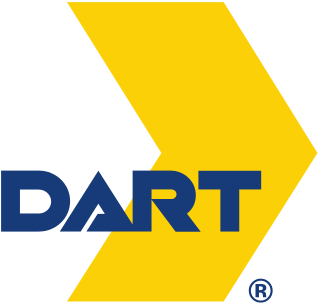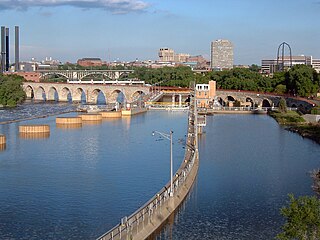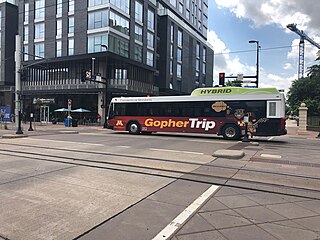Related Research Articles

Dallas Area Rapid Transit (DART) is a transit agency serving the Dallas–Fort Worth metroplex of Texas. It operates buses, light rail, commuter rail, and high-occupancy vehicle lanes in Dallas and twelve of its suburbs. In 2022, the system had a ridership of 42,499,600, or about 153,800 per weekday as of the second quarter of 2023.
Metro Transit is the primary public transportation operator in the Minneapolis–Saint Paul area of the U.S. state of Minnesota and the largest operator in the state. Although Metro Transit is one of the smallest transit systems for a large metropolitan area in the United States, it has previously been ranked as one of the best. In 2022, the system had a ridership of 38,794,700, or about 137,400 per weekday as of the second quarter of 2023.

King County Metro, officially the King County Metro Transit Department and often shortened to Metro, is the public transit authority of King County, Washington, which includes the city of Seattle. It is the eighth-largest transit bus agency in the United States. In 2022, the system had a ridership of 66,022,200, or about 249,900 per weekday as of the second quarter of 2023. Metro employs 2,716 full-time and part-time operators and operates 1,540 buses.

The Delaware Transit Corporation, operating as DART First State, is the only public transportation system that operates throughout the U.S. state of Delaware. DART First State provides local and inter-county bus service throughout the state and also funds commuter rail service along SEPTA Regional Rail's Wilmington/Newark Line serving the northern part of the state. The agency also operates statewide paratransit service for people with disabilities. DART First State is a subsidiary of the Delaware Department of Transportation (DelDOT).

The Southwest Ohio Regional Transit Authority (SORTA) is the public transport agency serving Cincinnati and its Ohio suburbs. SORTA operates Metro fixed-route buses, bus rapid transit, microtransit, and paratransit services. SORTA's headquarters are located at the Huntington Building in Cincinnati’s Central Business District. The agency is managed by CEO and General Manager Darryl Haley along with a 13-member board of trustees. In 2022, the system had a ridership of 9,664,000, or about 42,700 per weekday as of the second quarter of 2023.

Transportation in the U.S. State of Minnesota consists of a complex network of roadways, railways, waterways and airports. The transportation system is generally overseen by the Minnesota Department of Transportation, a cabinet-level agency of the state government. Additionally, regional governments such as the Metropolitan Council have authority over regional planning for the transportation system and local governments such as cities and counties oversee the local transportation network.

The Suburban Mobility Authority for Regional Transportation (SMART) is the public transit operator serving the suburbs of Detroit, Michigan, United States. Beginning operations in 1967 as the Southeastern Michigan Transportation Authority (SEMTA), the agency was reorganized and renamed SMART in 1989. SMART operates 44 bus routes, plus paratransit and microtransit services.

The San Diego Metropolitan Transit System is a public transit service provider for Central, South, Northeast, and Southeast San Diego County. The agency directly operates a large transit system that includes the MTS Bus, San Diego Trolley light rail, and Rapid bus rapid transit services. The MTS also controls the San Diego and Arizona Eastern (SD&AE) freight railway and regulates taxicabs, jitneys, and other private for-hire passenger transportation services.

Plymouth Metrolink is the public transit system that serves Plymouth, Minnesota. Metrolink operates fixed-route bus routes Monday-Friday during peak periods with limited midday service. Most routes serve downtown Minneapolis and the University of Minnesota with one route providing reverse commute service from Minneapolis to employers in Plymouth. Demand-responsive bus service is available seven days a week. Most buses are provided by the Metropolitan Council with First Transit operating the fixed-route service.

The University of Minnesota's Campus Shuttle is a zero-fare bus service operating on the University's Minneapolis and St. Paul campuses. In 2009, the system carried more than 3.9 million riders, making it the second-busiest transit system in Minnesota after the Twin Cities's primary provider Metro Transit. It outpaces all of the suburban transit providers in the Twin Cities, as well as providers in other metropolitan areas in the state. Duluth Transit Authority serving Duluth, Minnesota, and Superior, Wisconsin, is the state's third-busiest provider, while the Minnesota Valley Transit Authority ranks fourth. The shuttles are operated under contract by First Transit through the University's Parking and Transportation Services (PTS) department.
Quincy Transit Lines is the primary provider of mass transportation in Adams County, Illinois with four routes serving the region. As of 2019, the system provided 347,194 rides over 47,465 annual vehicle revenue hours with 8 buses and 8 paratransit vehicles.
Galesburg Transit is the primary provider of mass transportation in Knox County, Illinois with routes serving the Galesburg area. As of 2019, the system provided 160,712 rides over 23,487 annual vehicle revenue hours with 4 buses and 8 demand response vehicles.

Rochester Public Transit is the primary provider of mass transportation in Olmsted County, Minnesota with routes serving the Rochester area. As of 2019, the system provided 2,155,230 rides over 132,686 annual vehicle revenue hours with 68 buses and 10 demand response vehicles.

Winona Transit Service is the primary provider of mass transportation in Winona County, Minnesota with routes serving the Winona area. As of 2019, the system provided 225,350 rides over 17,171 annual vehicle revenue hours with 7 buses and 1 demand response vehicle.
D-TRAN is the primary provider of mass transportation in Dodge City, Kansas with three routes serving the region. As of 2019, the system provided 47,277 rides over 15,601 annual vehicle revenue hours with 3 buses and 4 paratransit vehicles.
Southern Minnesota Area Rural Transit (SMART) is a provider of mass transportation in Freeborn, Mower, Steele, and Waseca counties in Minnesota, with deviated fixed-routes serving the major cities, as well as demand-response service across the counties. The service is operated by Cedar Valley Services, Inc. In 2019 the system provided 272,878 rides over 62,048 annual vehicle revenue hours with 13 buses and 15 paratransit vehicles.
Central Community Transit (CCT) is the primary provider of mass transportation in Litchfield and Willmar, Minnesota with two routes serving the region in addition to countywide demand-response services. As of 2019, the system provided 227,429 rides over 51,272 annual vehicle revenue hours with 5 buses and 27 paratransit vehicles.
Community Transit is the primary provider of mass transportation in Marshall and Redwood Falls, Minnesota with four routes serving the region in addition to countywide demand-response services in eight counties. As of 2019, the system provided 223,558 rides over 67,578 annual vehicle revenue hours with 8 buses and 102 paratransit vehicles.
Hibbing Area Transit is the primary provider of mass transportation in Hibbing, Minnesota with one route serving the region. As of 2019, the system provided 53,890 rides over 9,382 annual vehicle revenue hours with 1 buses and 2 paratransit vehicles. Service hours have been expanded in recent years, as part of a state statute which requires MnDOT to provide greater funding to rural transit systems. Based on the population of the city, the city could support 12 hours of transit service on weekdays and 9 hours of service on weekends according to MnDOT.
Hiawathaland Transit is the primary provider of mass transportation in Faribault, Northfield and Red Wing, Minnesota with nine routes serving the region in addition to countywide demand-response services in three counties. It is a service of Three Rivers Community Action. As of 2019, the system provided 283,931 rides over 55,108 annual vehicle revenue hours with 12 buses and 8 paratransit vehicles.
References
- ↑ "Prairie Lakes Transit Agency Profile" (PDF). Retrieved October 4, 2023.
- ↑ "Board now in charge of bus system". Faribault County Register. October 2, 2016. Retrieved October 4, 2023.
- ↑ "Six new electric buses coming to Greater Minnesota transit agencies". KEYC News Now. August 23, 2022. Retrieved October 4, 2023.
- ↑ "Route Maps" . Retrieved October 4, 2023.
- ↑ "Hours of Service" . Retrieved October 4, 2023.
- ↑ "Rates" . Retrieved October 4, 2023.
- ↑ "The National Transit Database (NTD)" . Retrieved October 4, 2023.